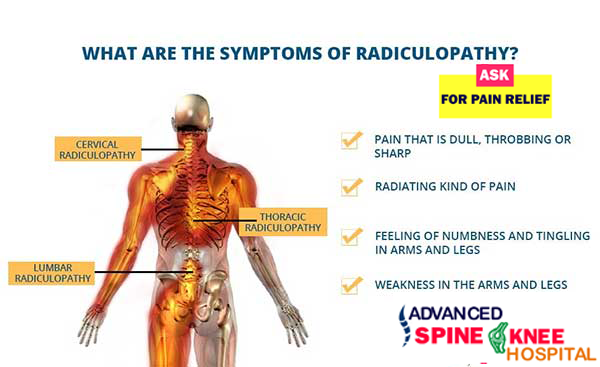LUMBAR RADICULOPATHY
Approximately 80% of the population is plagued at one time or another by back pain, especially lower back pain. Associated leg pain (called lumbar radiculopathy) occurs less frequently. Pain can be bothersome and debilitating, limiting daily activities. Leg and back pain can be caused by a variety of reasons, not all of which originate in your spine.
For the purpose of this article, we will focus on lumbar radiculopathy, which refers to pain in the lower extremities in a dermatomal pattern (see image below). A dermatome is a specific area in the lower extremity that has nerves going to it from a specific lumbar nerve. This pain is caused by compression of the roots of the spinal nerves in the lumbar region of the spine. Diagnosing leg and lower back pain begins with a detailed patient history and examination.
Medical History: Important when Diagnosing Lower Back Pain and Sciatica
At Advanced Spine and Knee Hospital, we first understand the problem with your medical history reports and detailed clinical Examinations. It is important to be specific when answering medical questions related to pain onset but remembering every detail is often not critical. Keeping records of your medical history, including medical problems, medications you are taking and surgeries you have had in the past is helpful.
Track Your Back and Leg Pain

Regarding your leg and back pain, it may be helpful to keep a Track of your activities, documenting when the pain began, the activities that aggravate your pain and those that relieve your symptoms. It is also important to determine whether your back pain is more bothersome than your leg pain or visa versa. You may be asked if you are experiencing any numbness or weakness in your legs or any difficulty walking. Remember, understanding the cause of your problem is based on the information you provide.
Most people describe ridiculer pain as a sharp or burning pain that shoots down the leg. This is what some people call sciatica. This pain may or may not begin in the low back. Leg pain caused by compressed nerve roots generally has specific patterns. These patterns of pain depend on the level of the nerve being compressed. After reviewing your history, your physician will perform a physical examination. This will help the physician determine if your symptoms are due to a problem that is caused by spinal nerve root compression. To help you understand the exam performed by your physician lets pause for a quick anatomy lesson.
Lumbar Radiculopathy Symptoms:
Lumbar radiculopathy symptoms may include pain, tingling, numbness, weakness, and reflex loss. Lumbar radiculopathy symptoms may present in the leg and foot.
Interventional treatments for lumbar radiculopathy may include:
- Physical therapy and/or exercises that are designed to stabilize the spine and promote a more open space for spinal nerve roots are recommended.
- Medications, such as non-steroidal anti-inflammatory drugs (NSAIDs) to reduce swelling and pain and analgesics to relieve pain.
- Epidural injections and Nerve root Injections to help reduce swelling and treat acute pain that radiates to the hips or down the leg.
- Cooled RadioFrequency Interventions

No Need — Surgical Treatment of Lumbar Radiculopathy:
Surgical treatment can be varied depending on what causes the lumbar radiculopathy. Typically, these treatments involve some way of either decompressing the nerve or stabilizing the spine.
Some of the surgical procedures used to treat lumbar radiculopathy at American Spine and Pain are:
- Anterior Lumbar Interbody Fusion (ALIF)
- Extreme Lateral Interbody Fusion (XLIF)
- Lumbar Laminectomy
- Lumbar Microdiscectomy
- Laminotomy
- Lumbar Spinal Fusion
- Transforaminal Lumbar Interbody Fusion (TLIF)
- Posterior Lumbar Interbody Fusion (PLIF)
- Cage implantation
- Pedicle Screw
- Deformity correction
Commentary by our Spine Expert:
Lumbar radiculopathy is a common problem that results when nerve roots are compressed or irritated. This excellent article discusses the basic anatomy and clinical manifestations of lumbar radiculopathy, which is often referred to generically as sciatica. These symptoms can be due to a variety of causes such as disc bulges, degenerative narrowing of the space for the nerves (spinal stenosis or foraminal stenosis), spinal instability, deformity of the vertebrae, or herniated disc fragments outside of the disc space.
In 70-80% of patients, lumbar radiculopathy is transient and resolves with nonsurgical treatments such as anti-inflammatory medications, physical therapy, exercise, spinal manipulation, or other nonsurgical modalities. A proportion of patients with sciatica require surgical intervention in instances where nonsurgical therapies have failed to provide adequate pain relief, and there is pathology [cause] that is presently compressing the nerves. A very small proportion of patients require urgent surgery. If a very large lumbar disc herniation causes severe nerve damage, with paralysis or acute bowel or bladder incontinence, then emergency surgery may be required.

